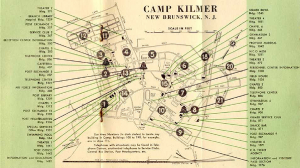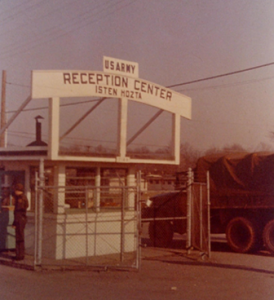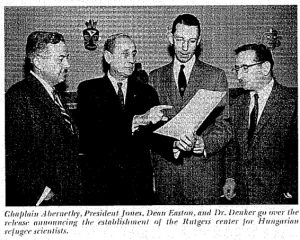 Note: Around October 23, the anniversary of the 1956 Hungarian Revolution, I can’t help feeling proud to remember how Rutgers stepped up and helped a small group of Hungarian scholars and graduate students.
Note: Around October 23, the anniversary of the 1956 Hungarian Revolution, I can’t help feeling proud to remember how Rutgers stepped up and helped a small group of Hungarian scholars and graduate students.
In our world of inexplicable hatred towards immigrants, I’d like to share a Rutgers story related to refugees who fled the Hungary after the Russians invaded Budapest on November 4, 1956.
In 2006, I was in the Archives processing the papers of the Reverend Bradford Abernethy, Rutgers University Chaplain and found a thin folder labeled Hungarian scientists. It turned out to be a treasure trove of information one often bumps into in archives, even though it took several years to track down the whole story that I am sharing below. Sources also include the Tracy D. Vorhees papers at Rutgers and my oral history interviews with refugee scientists.*
The President’s Committee for Hungarian Refugee Relief
President Eisenhower announced the appointment of the President’s Committee for Hungarian Refugee Relief on December 12. The Committee immediately became an operating agency to coordinate the work of government and private organizations, which facilitated the settlement of Hungarian political refugees. Tracy D. Voorhees served as the President’s personal representative as Chairman of the Committee in 1956 and 1957. Until the Committee was terminated after submitting its final report on May 14, 1957, it helped over 30,000 Hungarian refugees to resettle in the United States.
 NAS Hungarian Scholars Program
NAS Hungarian Scholars Program
Meanwhile, in November 1956, the National Academy of Sciences (the Academy) formally resolved to assist Hungarian colleagues who wished to continue their scholarly activities in the United States. In mid-December, the Academy initiated a structured program of professional evaluation and placement among qualified refugees.
At the same time, the Academy actively searched for positions by posting a request in Science magazine and in other media.They also started to build a database of available positions.
The Committee for Hungarian Refugee Relief embraced the initiatives. The Hungarian Scholar program was launched by establishing an office on December 19 at the official refugee center at Camp Kilmer, New Brunswick, NJ (currently, Piscataway, NJ). The purpose of the center was to help identify and place refugees with advanced scientific or other professional training. The office was open seven days a week, and witnessed a continuous flow of talented people with solid educational background in many areas. Refugees were screened and selected upon arrival in the United States based on their qualifications, educational, industrial, and research backgrounds.
Sixty-five hundred people were allowed to enter the US on immigrant visas, while the rest arrived on a “parolee” basis under an emergency provision of the Immigration Law, the former requiring a sponsor for one year, the latter with fewer legal requirements. Initial funding was provided by the Ford Foundation in the form of a previous grant to the Academy for its work in international relations. Later, the Rockefeller Foundation contributed to this program as well as others.
Camp Kilmer
 Besides the co-directors an administrative officer worked at Camp Kilmer as assistant director. The Academy’s office was located in Building 1305 of the camp, still US Army in the picture, but it was later renamed the Joyce Kilmer Reception Center. The welcome sign is in Hungarian. Even after Camp Kilmer was closed on April 30, 1957 and the President’s Committee was deactivated in May, 1957, the Academy’s teams continued to interview refugees in the new location at the Hotel St. George in Brooklyn from May 1 through December 8 as well as at its Mission in Vienna, Austria.
Besides the co-directors an administrative officer worked at Camp Kilmer as assistant director. The Academy’s office was located in Building 1305 of the camp, still US Army in the picture, but it was later renamed the Joyce Kilmer Reception Center. The welcome sign is in Hungarian. Even after Camp Kilmer was closed on April 30, 1957 and the President’s Committee was deactivated in May, 1957, the Academy’s teams continued to interview refugees in the new location at the Hotel St. George in Brooklyn from May 1 through December 8 as well as at its Mission in Vienna, Austria.
The main goal at Camp Kilmer was to identify scientists in areas where they would contribute to American science and industry the most, such as natural sciences, engineering, and medicine. First, a staff member of the Academy conducted extensive preliminary interviews. It was followed by more in-depth interviews, which also included counseling and an evaluation of the scientist’s potential. This second interview was conducted by a volunteer American expert from the refugee’s field from a pool of more than 30 professional members of universities located close to Camp Kilmer, such as Princeton, MIT, Columbia, Johns Hopkins. These experts were sometimes able to suggest a specific academic or industrial opening available immediately.
 Then the Academy’s placement officer reviewed the refugee’s options with the help of a master file of position openings. It was compiled from submissions of academic and industrial employers invited by the Academy to assist, or from jobs offered by employers after reading about the program in the press. No corporation and industry representatives were allowed to conduct similar interviews at Camp Kilmer.
Then the Academy’s placement officer reviewed the refugee’s options with the help of a master file of position openings. It was compiled from submissions of academic and industrial employers invited by the Academy to assist, or from jobs offered by employers after reading about the program in the press. No corporation and industry representatives were allowed to conduct similar interviews at Camp Kilmer.
This office placed more than 500 scientists from among 750 interviewed, even though the program did not always go smoothly (refugees interviewed by the Academy disappeared, were picked up by American relatives, or were sent to distant areas in the country without notifying the NAS representatives.
The Rutgers Program
It was recognized early in the program that many of the Hungarian refugee scientists would not be able to find appropriate jobs due to their limited English proficiency. At this point, in cooperation with Lewis Webster Jones, President of Rutgers University and David Denker, Assistant Provost, Rutgers made its facilities available and offered an eight-week language immersion program directed by University Chaplain, the Rev. Bradford Abernethy.
 The screening protocol was extremely important. The sponsor, the Rockefeller Foundation, emphasized that the purpose was to assist in preserving and developing brain capacity, instead of just providing relief and resettlement opportunities for refugees who happened to be students.
The screening protocol was extremely important. The sponsor, the Rockefeller Foundation, emphasized that the purpose was to assist in preserving and developing brain capacity, instead of just providing relief and resettlement opportunities for refugees who happened to be students.
At Rutgers, the pioneering language and cultural immersion program was launched on January 13, 1957 with the first group of ten people, and ended on March 15, 1957, after the certificates were officially awarded. The appointed director of the program was the University Chaplain, who previously also served as Director of the European student seminar program of the American Friends Service Community in 1953-54.
Dr. Stephen Temessy worked for the program as an assistant to the director, translator, interpreter, reporter and analyst of group feeling. He also lived in the dorm with the scientists, and was on-call at all times Monday through Friday. The language teaching faculty included three members of the Department of Romance Languages. The total budget for the course was $17,690, from which staff salaries, dorm fees and overhead costs ranked the highest, around $5,000 each.
The group of single individuals, couples, and two families with one child each were housed and attending classes in Building no. 3 of the new Rutgers dormitory-classroom development in New Brunswick. This building was scheduled for Rutgers students’ occupancy only in the fall semester, and it provided both living quarters and classrooms for the Hungarian refugees on the entire third floor and half of the second floor, including lobbies on each floor, used for evening lectures or as a lounge and recreation room. Meals were provided in the University Commons on meal tickets, and each person received a small weekly allowance. Immediate clothing needs were handled right after arrival, and later the Women’s League of Rutgers also rushed to help with a private collection of clothing. Health care needs were minimal, since there were doctors in the group.
Continued in Hungarian Refugee Scientists at Rutgers (Part 2)
*Based on the author’s presentation: The Rutgers English Program for Hungarian Refugee Scientists in 1956. Invited talk at the Rutgers 250th Anniversary event: The Cold War at Camp Kilmer: Hungarian ‘56ers, Cubans, and US Refugee Policy in New Jersey. March 2, 2016.
Research conducted at the Information Services, Center of Alcohol Studies (2007-2016). Co-investigators: Sylvia D. Clark (St. John’s University), Frank Jolliffe (Bank Street College), Molly Stewart (Center of Alcohol Studies Library, Franklin Township Public Library).
Images: Rutgers Special Collections and University Archives